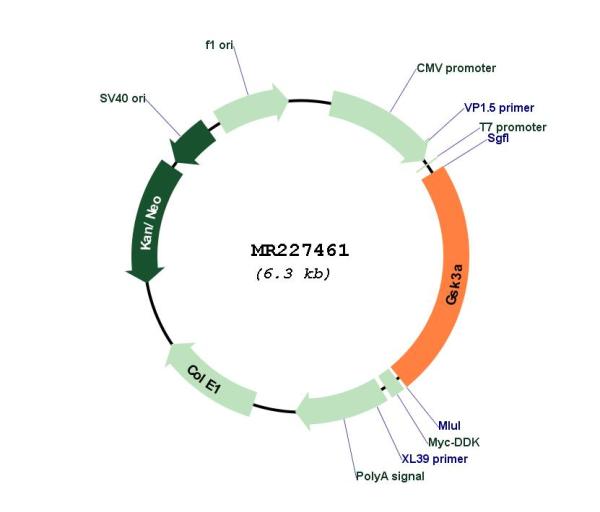Gsk3a (NM_001031667) Mouse Tagged ORF Clone
CAT#: MR227461
- TrueORF®
Gsk3a (Myc-DDK-tagged) - Mouse glycogen synthase kinase 3 alpha (Gsk3a)
ORF Plasmid: tGFP
Lentiviral Particles: DDK w/ Puro mGFP w/ Puro
AAV Particle: DDK
"NM_001031667" in other vectors (4)
Interest in protein/lysate? Submit request here!
USD 198.00
Specifications
| Product Data | |
| Type | Mouse Tagged ORF Clone |
| Tag | Myc-DDK |
| Symbol | Gsk3a |
| Synonyms | 2700086H06Rik |
| Vector | pCMV6-Entry |
| E. coli Selection | Kanamycin (25 ug/mL) |
| Mammalian Cell Selection | Neomycin |
| Sequence Data |
>MR227461 representing NM_001031667
Red=Cloning site Blue=ORF Green=Tags(s) TTTTGTAATACGACTCACTATAGGGCGGCCGGGAATTCGTCGACTGGATCCGGTACCGAGGAGATCTGCC GCCGCGATCGCC ATGAGCGGCGGCGGGCCTTCGGGAGGCGGCCCTGGGGGCTCGGGCCGGGCGCGGACCAGCTCGTTCGCGG AGCCAGGAGGCGGAGGCGGAGGTGGTGGCGGCGGCCCCGGGGGCTCGGCCTCTGGCCCAGGAGGCACTGG CGGCGGGAAAGCGTCAGTCGGGGCTATGGGTGGGGGCGTGGGAGCCTCGAGCTCCGGGGGTGGCCCCAGC GGCAGCGGCGGAGGAGGCAGCGGTGGCCCCGGCGCGGGCACTAGCTTCCCGCCGCCGGGAGTGAAGCTGG GCCGTGACAGCGGGAAGGTGACCACAGTGGTAGCCACTGTAGGCCAAGGCCCAGAGCGTTCCCAAGAAGT GGCTTACACTGACATCAAAGTGATTGGTAATGGCTCATTCGGAGTAGTATACCAGGCACGGCTGGCAGAG ACGAGGGAACTGGTGGCCATCAAGAAGGTTCTTCAGGACAAAAGGTTCAAGAACCGAGAACTGCAGATTA TGCGTAAGCTGGACCACTGCAATATTGTGAGGCTGCGGTACTTTTTCTACTCCAGTGGGGAGAAGAAGGA CGAGCTGTATTTGAATCTGGTGCTGGAGTATGTGCCCGAGACGGTGTACCGAGTGGCCCGCCACTTCACC AAGGCCAAGCTGATCACCCCTATCATCTACATCAAGGTGTACATGTACCAGCTCTTCCGGAGCTTGGCCT ACATCCACTCCCAAGGTGTGTGTCACCGTGACATCAAGCCCCAGAATTTGCTTGTGGACCCTGACACTGC TGTCCTCAAGCTCTGCGATTTTGGCAGTGCAAAGCAGCTGGTTCGGGGGGAGCCCAATGTGTCCTACATC TGCTCTCGGTACTACCGTGCTCCAGAACTCATCTTTGGAGCCACAGATTACACCTCGTCCATCGATGTGT GGTCGGCTGGCTGTGTACTTGCTGAGCTACTTCTCGGCCAGCCCATCTTCCCTGGGGACAGTGGGGTGGA CCAGCTTGTGGAGATCATCAAGGTACTAGGAACGCCAACCAGGGAACAAATCCGAGAGATGAACCCTAAC TATACGGAGTTCAAGTTCCCCCAGATCAAAGCTCACCCTTGGACAAAGGTGTTCAAATCTTCAAAGACAC CACCTGAGGCCATTGCACTCTGCTCTAGCCTACTGGAGTACACGCCATCCTCAAGGCTCTCCCCACTCGA GGCTTGTGCCCACAGCTTCTTCGATGAACTGCGGAGACTCGGAGCCCAGCTCCCCAACGACCGCCCGCTT CCCCCCCTGTTCAACTTCAGTCCTGGTGAACTGTCCATCCAACCATCTCTCAATGCCATTCTCATCCCTC CTCACTTGAGGTCCCCAGCAGGCCCTGCTTCTCCCCTCACCACTTCCTACAACCCATCCTCACAAGCTTT AACTGAAGCTCAGACTGGCCAAGATTGGCAGCCATCTGATGCCACAACTGCTACCCTCGCTAGCTCTTCC ACGCGTACGCGGCCGCTCGAGCAGAAACTCATCTCAGAAGAGGATCTGGCAGCAAATGATATCCTGGATT ACAAGGATGACGACGATAAGGTTTAA >MR227461 representing NM_001031667
Red=Cloning site Green=Tags(s) MSGGGPSGGGPGGSGRARTSSFAEPGGGGGGGGGGPGGSASGPGGTGGGKASVGAMGGGVGASSSGGGPS GSGGGGSGGPGAGTSFPPPGVKLGRDSGKVTTVVATVGQGPERSQEVAYTDIKVIGNGSFGVVYQARLAE TRELVAIKKVLQDKRFKNRELQIMRKLDHCNIVRLRYFFYSSGEKKDELYLNLVLEYVPETVYRVARHFT KAKLITPIIYIKVYMYQLFRSLAYIHSQGVCHRDIKPQNLLVDPDTAVLKLCDFGSAKQLVRGEPNVSYI CSRYYRAPELIFGATDYTSSIDVWSAGCVLAELLLGQPIFPGDSGVDQLVEIIKVLGTPTREQIREMNPN YTEFKFPQIKAHPWTKVFKSSKTPPEAIALCSSLLEYTPSSRLSPLEACAHSFFDELRRLGAQLPNDRPL PPLFNFSPGELSIQPSLNAILIPPHLRSPAGPASPLTTSYNPSSQALTEAQTGQDWQPSDATTATLASSS TRTRPLEQKLISEEDLAANDILDYKDDDDKV |
| Chromatograms |
CHROMATOGRAMS
 Sequencher program is needed, download here. |
| Restriction Sites |
SgfI-MluI
Cloning Scheme for this gene
Plasmid Map

|
| ACCN | NM_001031667 |
| ORF Size | 1470 bp |
| OTI Disclaimer | The molecular sequence of this clone aligns with the gene accession number as a point of reference only. However, individual transcript sequences of the same gene can differ through naturally occurring variations (e.g. polymorphisms), each with its own valid existence. This clone is substantially in agreement with the reference, but a complete review of all prevailing variants is recommended prior to use. More info |
| OTI Annotation | This clone was engineered to express the complete ORF with an expression tag. Expression varies depending on the nature of the gene. |
| Product Components | The ORF clone is ion-exchange column purified and shipped in a 2D barcoded Matrix tube containing 10ug of transfection-ready, dried plasmid DNA (reconstitute with 100 ul of water). |
| Reconstitution | 1. Centrifuge at 5,000xg for 5min. 2. Carefully open the tube and add 100ul of sterile water to dissolve the DNA. 3. Close the tube and incubate for 10 minutes at room temperature. 4. Briefly vortex the tube and then do a quick spin (less than 5000xg) to concentrate the liquid at the bottom. 5. Store the suspended plasmid at -20°C. The DNA is stable for at least one year from date of shipping when stored at -20°C. |
| Reference Data | |
| RefSeq | NM_001031667.1, NP_001026837.1 |
| RefSeq Size | 2276 bp |
| RefSeq ORF | 1473 bp |
| Locus ID | 606496 |
| UniProt ID | Q2NL51 |
| Cytogenetics | 7 A3 |
| MW | 52.1 kDa |
| Gene Summary | Constitutively active protein kinase that acts as a negative regulator in the hormonal control of glucose homeostasis, Wnt signaling and regulation of transcription factors and microtubules, by phosphorylating and inactivating glycogen synthase (GYS1 or GYS2), CTNNB1/beta-catenin, APC and AXIN1 (PubMed:15791206, PubMed:17908561). Requires primed phosphorylation of the majority of its substrates (PubMed:22539723). Contributes to insulin regulation of glycogen synthesis by phosphorylating and inhibiting GYS1 activity and hence glycogen synthesis (PubMed:15791206, PubMed:17908561). Regulates glycogen metabolism in liver, but not in muscle (PubMed:17908561). May also mediate the development of insulin resistance by regulating activation of transcription factors (By similarity). In Wnt signaling, regulates the level and transcriptional activity of nuclear CTNNB1/beta-catenin (PubMed:15791206). Facilitates amyloid precursor protein (APP) processing and the generation of APP-derived amyloid plaques found in Alzheimer disease (By similarity). May be involved in the regulation of replication in pancreatic beta-cells (By similarity). Is necessary for the establishment of neuronal polarity and axon outgrowth (PubMed:17391670). Through phosphorylation of the anti-apoptotic protein MCL1, may control cell apoptosis in response to growth factors deprivation (PubMed:16543145). Acts as a regulator of autophagy by mediating phosphorylation of KAT5/TIP60 under starvation conditions, leading to activate KAT5/TIP60 acetyltransferase activity and promote acetylation of key autophagy regulators, such as ULK1 and RUBCNL/Pacer (PubMed:22539723).[UniProtKB/Swiss-Prot Function] |
Documents
| Product Manuals |
| FAQs |
| SDS |
Resources
Other Versions
| SKU | Description | Size | Price |
|---|---|---|---|
| MC216926 | Gsk3a (untagged) - Mouse glycogen synthase kinase 3 alpha (Gsk3a), (10ug) |
USD 503.00 |
|
| MG227461 | Gsk3a (tGFP-tagged) - Mouse glycogen synthase kinase 3 alpha (Gsk3a), (10ug) |
USD 657.00 |
|
| MR227461L3 | Lenti ORF clone of Gsk3a (Myc-DDK-tagged) - Mouse glycogen synthase kinase 3 alpha (Gsk3a) |
USD 757.00 |
|
| MR227461L4 | Lenti ORF clone of Gsk3a (mGFP-tagged) - Mouse glycogen synthase kinase 3 alpha (Gsk3a) |
USD 757.00 |
{0} Product Review(s)
Be the first one to submit a review






























































































































































































































































 Germany
Germany
 Japan
Japan
 United Kingdom
United Kingdom
 China
China


